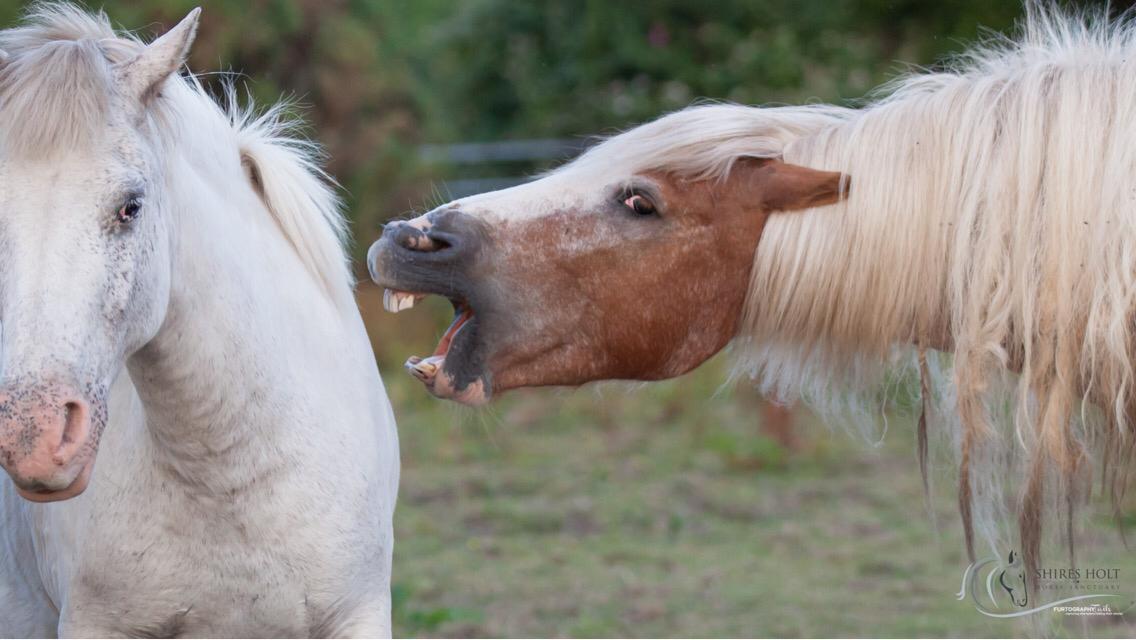Aggression - What's with the angry face ?
I often see aggressive horses during my work, from a “typical grumpy mare” to very dangerous, proactive aggressive cases. In a natural environment with plentiful resources horses are an afiliative species that have numerous facial and body expressions that alleviate the need for aggression.
Aggression between horses in the domestic environment is too common, this reflects how stressed our horses can be within a domestic environment. Assessing the cause of the aggression is crucial: it can be fear based, pain based, learnt, protective, redirected, maternal or hormone based, to name a few. Without a good idea of the cause, you cannot facilitate a constructive plan to reduce or eliminate the aggression. As a behaviourist, I work under vet referral to be sure that I am treating a behavioural issue and not one that is based on a physiological problem. Pain or hormonal changes are common physical issues that can create behavioural problems. Any sudden behaviour change should be investigated by a vet.
If we think of the horses natural reactions to unpleasant experiences in their life (aversive stimuli) we think of the 4 F’s; fidget, freeze, flight and fight. Fight is the last response to be utilised as it expends energy and it risks injury to the horse itself. Horses don’t generally fight the plastic bag in the hedge, they often freeze, fidget about and then flee - not often would a horse immediately attack it - thankfully! However, if a horse is continually pushed to fight, by being constrained or having its fidget or freeze ignored, then it can become their first response to even mildly aversive stimuli, they learn that there is little point showing the other behaviours as they are not listened to. The horse learns it has to shout to be heard.
When a horse starts to be aggressive it can quickly become an aggression cycle; the more they are aggressive and the more they are in that state; the quicker they return to it and the longer they stay there. It is so important to reduce or eliminate the horses need to be aggressive. When you reduce their motivstion to show aggressive behaviour, you are reducing the hormones and brain chemicals that are triggering and being maintained by the aggressive state. Only when you reduce those chemicals and facilitate experiences that start a release the feel good hormones and brain chemicals can you start to make serious and long term change to a horses emotional state.
A common reaction to horses aggression is positive punishment, often this is done almost without thought as an owner or animal being targeted by an aggressive horse will normally be acting in self defence. However whats important to remember is that often the first thing that occurs when a horse initiates an aggressive act is that the person or animal that it is being directed towards moves away. This is potentially reinforcing the aggressive behaviour from the release of pressure and the creation of space. If we consider feet handling as an example, a horse feels uncomfortable with people handling its hind legs, it can tolerate its trusted owner however when a farrier visits there are many changes to the normal routine and a trigger stacking scenario begins. We have the stress of the hind legs being touched and lifted, plus a strange person, plus funny smells and noises, this pushes the horse over its stress threshold. The horse starts to fidget, it is corrected and told to stand, the horse fidgets more and is firmly corrected and told to stand still. The horse remains stressed as nothing has been done to relieve the stress. The horse snatches its leg away and lashes out. The hold on the foot is released, win! The horse is then told off for being naughty, which further increases the horses fear. The leg is asked for again, what would your reaction be? It is easy to see how problems arise and become worse during horse handling.
So how should you react if your horse starts to become aggressive. The most important thing is to remain safe, do not try and fix the aggressive behaviour yourself. Enlist the help of an expert who can assist you in making appropriate changes to the environment and handling to reduce the need for the aggression. Only then can a more appropriate response be trained with a systematic plan.
Image credit Furtography Tails Pet Photography



